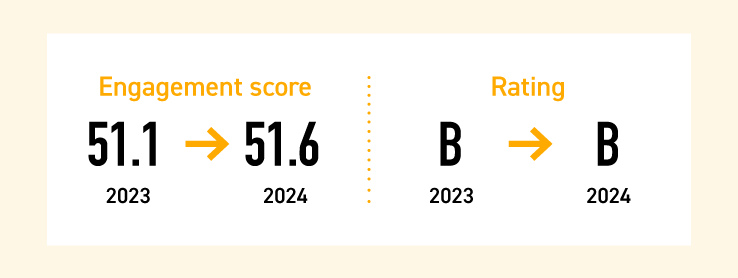Human Capital Management
Human resource development policy
In order for MDV to achieve sustainable growth and realize its management philosophy, which has been in place since its founding, it must form an organizational structure and culture in which all employees understand and practice the corporate culture and are empowered to continue taking on challenges.
In order to cultivate employees who will form this culture, MDV positions human resource development as one of its most important management measures. We aim to 1) instill our management philosophy, 2) create an environment that encourages people to take on challenges, and 3) provide the opportunity to experience growth. Using these three pillars as the basis of our approach, we will create an organization in which diverse human resources can actively participate.
Three measures based on the human resource development policy
- Change employee awareness by instilling MDV’s management philosophy and management policies (instilling our management philosophy)
- Create an environment in which people can continue to take on challenges without being tied to existing businesses (encouraging people to take on challenges)
- Establish a system that enables people to experience growth and give back (providing a real sense of growth)
Internal environmental improvement policy
Based on our human resource development policy, we provide fair opportunities to take on challenges, experience actual growth and actively participate in an environment in which all employees can maintain good physical and mental health and perform to the best of their ability. In order to do so, we have put the following three measures in place.
Three measures based on the internal environmental improvement policy
- Create an environment in which diverse human resources can be assigned, understood, challenged and empowered to actively contribute
- Ensure employee health and safety
- Create good labor-management relations and a working environment that enables coordination and cooperation
Conducting employee engagement surveys
We believe that employee engagement is critical to creating an organization where each individual can be at their best and where there is job satisfaction. In order to ascertain and resolve organizational issues, we introduced an employee engagement survey in fiscal 2023. The results of the fiscal 2024 survey showed that there are issues concerning communication between hierarchical levels and employees’ satisfaction with the strategic targets, as in fiscal 2023.
In response, we held study groups with the heads of each business division, who identified issues of high concern and formulated an action plan. As a Companywide measure, we explained the background of activities in our key businesses, provided semiannual progress reports, and held Q&A sessions to foster a sense of satisfaction among all employees.

Note: The survey utilizes the Motivation Cloud service by Link and Motivation Inc.
Database of Companies Promoting the Advancement of Women (Ministry of Health, Labour and Welfare)
https://positive-ryouritsu.mhlw.go.jp/positivedb/detail?id=51322Ryoritsu Shien no Hiroba (Database of action plan to Support Raising Next-Generation Children)
https://ryouritsu.mhlw.go.jp/hiroba/search_dtl.php?cn=35509#actionplanAction Plan
Action Plan Based on the Act for the Promotion of Women’s Active Engagement in Professional Life
The following action plan has been formulated to allow employees to balance work with childcare and to allow all employees to demonstrate their abilities.
- 1.Plan Period: November 10, 2023, through December 31, 2026
- 2.Numerical Goals
Goal 1: Women to fill up to at least 30% of management positions
<Action Details>
- From January 2024 Set up and implement opportunities for interviews regarding the direction of career development
- From March 2024 Review the contents of career development training
- From June 2024 Select candidates and implement career development training
- From January 2025 Appoint female candidate to management role
Goal 2: The percentage of men taking childcare leave to reach 100%
<Action Details>
- From January 2024 Raise awareness of the support system for balancing work with childcare, which is available to promote childcare leave
- From March 2024 Collect information on the support system for balancing work with childcare and review it as needed
- From June 2024 Conduct diversity management training for managers
The following action plan has been formulated to allow employees to balance work with childcare and nursing care and to create an environment conducive to working so that all employees can fully demonstrate their abilities.
- 1.Plan Period: Five years from January 1, 2020, to December 31, 2024
- 2.Content
Goal 1: Raise the age at which the short working hours system for childcare can be used (from up to 3 years old to before entering elementary school).
<Actions>
- Start discussing details of the system
- Introduce the system, and inform employees through internal bulletin boards, morning meetings, etc.
Goal 2: Establish a system allowing employees to take sickness/injury childcare leave and nursing care leave on a half-day basis.
<Actions>
- Start discussing details of the system
- Introduce the system, and inform employees through internal bulletin boards, morning meetings, etc.
Goal 3: Increase the number of days available to fathers for taking leave at the time of a child’s birth.
<Actions>
- Start discussing details of the system
- Introduce the system, and inform employees through internal bulletin boards, morning meetings, etc.
